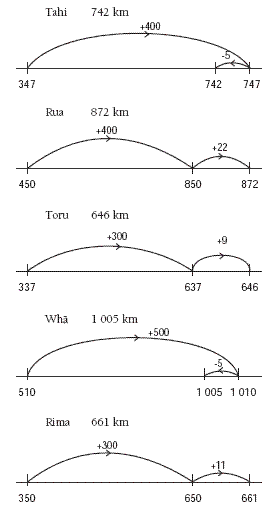This is a level 3 number activity from the Figure It Out series. It relates to Stage 6 of the Number Framework.
A PDF of the student activity is available.
Click on the image to enlarge it. Click again to close. Download PDF (220 KB)
solve addition problems on a number line
FIO, Level 3, Number, Book 2, Tracking Toroa, page 1
The toroa theme uses an interesting local context to apply addition and subtraction. This sort of context enables the students to understand the problem before deciding on a way to solve it.
The empty (or open) number line offers a diagrammatic way for students to devise and explain a strategy for solving the problems. This visual model also encourages the students to come up with the advanced additive stage strategies described in the Number Framework.
An empty number line marks the steps in thinking used by the students. Unlike the traditional number line, it is not intended to be a calculating tool that uses equal divisions.
Discuss the tidy number strategy that is used in the number line example of Tahi’s flight distance for days 5 and 6. Make sure that the students notice the directional change in the arrows: the 299 is rounded up to 300 and added to 329, and then the arrow is reversed to subtract 1 to adjust the tidy number.
There are other possible number lines apart from those shown in the Answers that can be used to solve each question. The students’ lines should match the thinking strategies they have used and result in the correct answer. Have some students share their ways of thinking.
The key to question 2 is the strategy the students choose to find the birds that fit the conditions. The easiest way, as given in the hint, would be to find 2 numbers in the ones place for each bird on Òriwa’s distance table that add up to the number required in that place and then test to see if the choice is correct. Some students may look at the hundreds place for 2 numbers that add up to either the same or 1 less than the required number, then check to confirm their choice.
Have the students discuss some of the strategies they used to confirm the exact answer.
The best strategy for question 3 is for the students to start from 1 762 kilometres. Students who add the first 5 days again will arrive at the correct answer, but they won’t have used the information in the question to best advantage.
In question 4, the students cannot presume that the question applies to the first 4 days, so they need to find out which 4 days add up to 1 429 kilometres. When they have done this, they may choose to add up the distances for the first 3 of those 4 days. This is fine, but the question is designed to encourage subtraction (1 429 – the fourth day = total of the first 3 of those days).
Ask the students to find a way that makes use of all the information in the question. Discuss the strategies used and encourage the students to use empty number lines as part of their explanation.
Encourage the students to make up their own problems using the toroa context. They should be able to work out their own problem so that they can then explain it to others. Encouraging them to think about and explain the problems they make up will ensure that they do not choose numbers that are ridiculous.
Answers to Activity
1. Answers and possible number lines are:
2. a. Rua. (Days 5 and 6)
b. Toru. (Days 9 and 10)
c. Whā. (Days 1–4)
3. 2 412 km. A possible number line is:
4. 1 047 km. (Days 3, 4, and 5)

